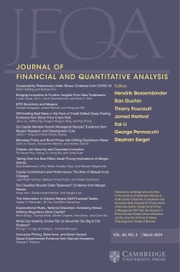No CrossRef data available.
Article contents
The Valuation of Corporate Coupon Bonds
Published online by Cambridge University Press: 07 April 2025
Abstract
This article proposes and estimates a tractable, arbitrage-free valuation model for corporate coupon bonds that includes a more realistic recovery rate process. Most existing studies use a recovery rate process that is misspecified because it includes recovery for coupons due after default. Misspecification errors from assuming recovery on all coupons can be substantial; they increase with recovery rates, coupons, maturity, and default probabilities. For a large sample of market transactions, i) our model has lower pricing errors than one assuming recovery on all coupons and ii) the magnitude of our model’s outperformance is linked to misspecification errors from assuming recovery on coupons.
- Type
- Research Article
- Information
- Creative Commons
- This is an Open Access article, distributed under the terms of the Creative Commons Attribution licence (http://creativecommons.org/licenses/by/4.0), which permits unrestricted re-use, distribution and reproduction, provided the original article is properly cited.
- Copyright
- © The Author(s), 2025. Published by Cambridge University Press on behalf of the Michael G. Foster School of Business, University of Washington
Footnotes
Helpful comments from two anonymous referees, Hendrik Bessembinder (the editor), John Y. Campbell, and seminar participants at the Bank of England, the Bank of Finland, the Board of Governors of the Federal Reserve, the European Bank for Reconstruction and Development, the International Monetary Fund, the World Bank, Brandeis University, the 2019 GEA meetings at the Frankfurt School of Finance and Management, and the University of Technology, Sydney are gratefully acknowledged. We thank Tengda Gong for providing excellent research assistance.


